Grade 6 - Full Year Math Bundle - Ontario New 2020 Curriculum
Grade 6 - Full Year Math Bundle - Ontario New 2020 Curriculum
Interested in a bundle? Shop below instead!
Couldn't load pickup availability
PRODUCT PREVIEW
Grade 6 - New Ontario Math Curriculum 2020 – This bundle covers all expectations in the Grade 6 - New Ontario Math Curriculum. Included are 1250 activity sheets for your students to learn the overall and specific expectations outlined by the Ministry of Education.
Check out each of the strands below to learn more about the resources included in this bundle. This product includes both the PDF and Google Slides versions.
Strand B - Number (Number Sense and Operations)
Concepts that are covered:
- Composing and decomposing whole numbers to one million
- Read and represent integers using horizontal and vertical number lines
- Comparing integers, decimal numbers, and fractions
- Equivalent fractions
- Read, represent, compare, and order decimal numbers up to thousands
- Round decimal numbers – both terminating and repeating
- Divisibility rules
- Mental math – addition, subtraction, estimation
- Mental math – calculating percents of whole numbers
- Adding and subtracting whole numbers and decimals numbers
- Add and subtract fractions with like and unlike denominators
- Composite and prime numbers using factor trees
- Multiplying three-digit numbers by decimal tenths
- Dividing three-digit numbers by decimal tenths
- Dividing decimal numbers up to thousands by whole numbers
- Multiplying and dividing whole numbers by fractions
- Rates and ratios
- Converting ratios to percentages
- 4 Unit Tests – Place Value, Number Sense, Adding/Subtracting, Multiplying/Dividing
Strand C - Algebra (Patterns, Equations, Coding)
- Repeating Patterns (different shapes, sizes, colours, orientations)
- Translating growing and shrinking patterns using tables of values and graphs
- Increasing/Decreasing patterns using all 4 operations (addition, subtraction, multiplication and division)
- Extending growing, shrinking, and repeating patterns
- Determining pattern rules and pattern cores
- Table of Values
- Linear patterns
- Creating and describing patterns using whole numbers and decimal to the hundredths
- Graphing table of values
- Solving patterns using algebraic expressions and equations
- Investigating decimals patterns using number strings
- Solving using variables
- Adding monomials with a degree of 1
- Balancing equations using all 4 operations
- Evaluating algebraic expressions
- Solve inequalities involving two operations and whole numbers to 100
- Writing code
- Interpreting code
- Using loops in code
- Concurrent codes – writing codes for events that happen simultaneously
- Conditional codes – If and Then codes – Control structures
- Coding games using if/then codes
- 3 Unit Tests – 1 for each overall expectation
Strand D - Data (Data Literacy and Probability)
- Difference between discrete and continuous data
- Difference between qualitative and quantitative data
- Difference between primary and secondary data
- Understanding the importance of random sampling
- Investigating the different random sampling techniques
- Using frequency tables
- Interpreting bar graphs and stacked-bar graphs
- creating pictographs, bar graphs, histograms, broken-line graphs, and stacked-bar graphs
- determining the mean, median, mode, and range of data sets
- Creating an appropriate scale for a graph as well as labels
- Creating and interpreting infographics
- Drawing conclusions about different sets of data
- Thinking critically about misleading graphs
- Creating misleading graphs
- Describing the likelihood of an outcome (impossible, unlikely, equally likely, likely, and certain)
- Using a probability line to decide the probability of an event
- Using fractions, decimals, and percent to represent the probability of an event
- Understanding the difference between theoretical and experimental probability
- Performing experimental probability of two independent events
- Determining the theoretical probability of two independent events using tree diagrams
Strand E - Spatial Sense
- Parallel, perpendicular, and intersecting lines
- Geometric properties of quadrilaterals
- Types of quadrilaterals
- Diagonals and Rotational Symmetry in Quadrilaterals
- Drawing top, front, and side views of objects
- Reading and plotting coordinates in all four quadrants
- Describing translations in all four quadrants of a cartesian plane
- Translations, reflections, and rotations of up to 360 degrees on a grid
- Converting units of measurement
- Using a protractor to determine angle size of up to 360 degrees
- Constructing angles up to 360 degrees
- Using Supplementary, complementary, and opposite angles to determine unknown angles
- Using Interior and exterior angles to determine unknown angles
- Calculating the area of trapezoids, rhombuses, kites, and composite polygons
- Comparing prisms and pyramids using their nets
- Calculating surface areas of prisms and pyramids using nets
- Calculating surface areas of prisms and pyramids
Strand F - Financial Literacy
- Curriculum Connections
- Main Methods of Payment
- Methods of Payment – Questions
- Different Forms of Payment
- Forms of Payment – Questions
- Methods of Payment – Advantages/Disadvantages
- Methods of Payment – Advantages/Disadvantages – Questions
- Methods of Payment – Blog Post Assignment
- Methods of Payment – Blog Post – Organizer
- Blog Post Writing Assignment
- Methods of Payment – Poster Assignment - Organizer
- Methods of Payment – Poster Assignment – Paper
- Financial Spending Goals
- Financial Earning Goals
- My Spending Financial Goals
- My Spending Financial Goals
- Negative Factors Affecting Financial Goals
- Negative Factors – Financial Goals - Questions
- Positive Factors Affecting Financial Goals
- Positive Factors – Financial Goals - Questions
- Factors Affecting Financial Goals
- Reaching Financial Goals
- Credit and Debit
- Introduction to Interest Rates
- Interest Rates – Reading
- Interest Rates – Questions
- Calculating Interest – Investments
- Calculating Interest – Borrowing
- Calculating Interest – Word Problems
- Fees – Banking and Borrowing
- Fees – Banking and Borrowing – Questions
- Choosing a Bank Account
- Creating Bank Account Details - Assignment
- Trading
- Donating
- Distribution of Financial Resources
- Financial Literacy – Unit Test
**ANSWER PAGES INCLUDED**
These are comprehensive units that will save you hours of planning! They have been tested and found effective in helping students achieve the learning goals setup by the Ministry of Education in their new math curriculum.
Share
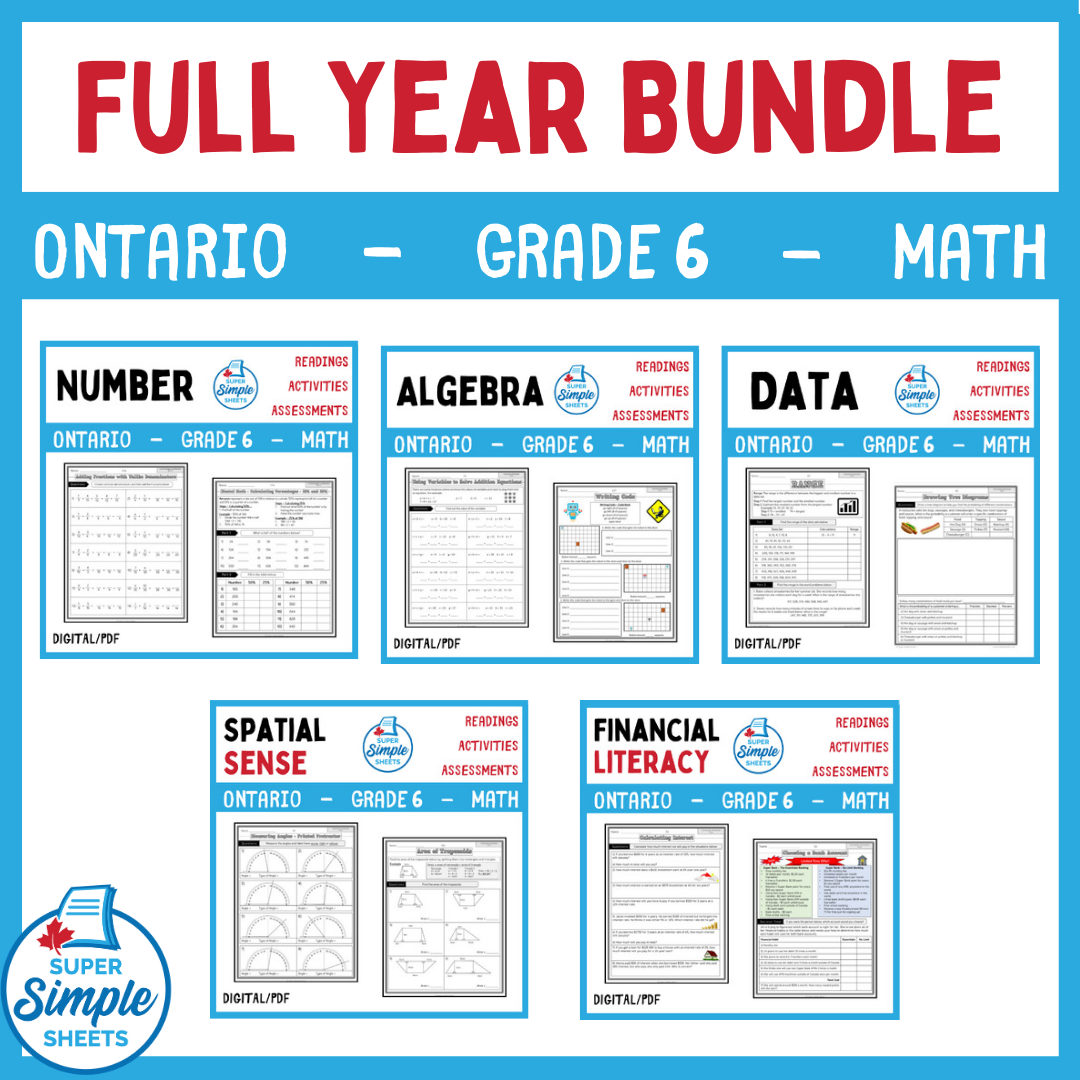
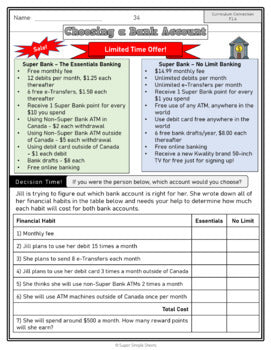
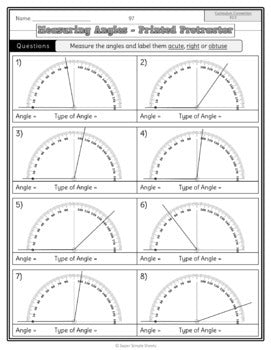
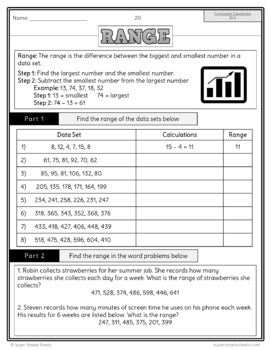

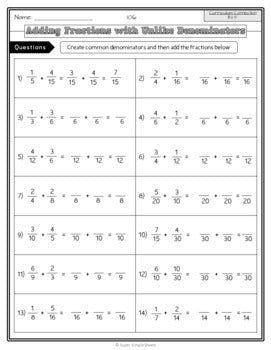
Given that teachers are provided with next to no resources from the school boards these days, having practice sheets at my fingertips for every concept has been a HUGE timesaver!
I have purchased many things from SSS over the years, so I knew when I was assigned to a new grade this year that this would be my go-to. This math package covers it all in a well laid out manner, easy for students to understand.
Lots of great activities!
Excellent package for students
I appreciate the Grade 6 package for Ontario. The progression and pacing were very appropriate for my students!









